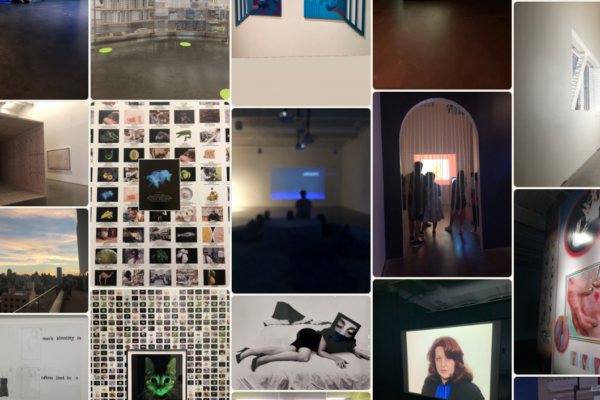- What We Do
- Understanding your audience
- Engaging new audiences
- Designing experiences
- Building loyalty
 Case studies
Case studiesNew Museum: Audience insight and website evaluation
The New Museum of Contemporary art is a pioneering New York art museum embracing a diverse and thought-provoking array of art from around the globe. In 2021, they approached MHM with a twofold problem.

The New Museum needed to find out:
1. How can we better understand, and connect with our audiences?
The New Museum wanted to explore visitors’ perceptions of contemporary art in general, as well as the visit experience itself. What is a visit to the New Museum like, and how does it compare to other major art museums in the city? What motivates visitors to come, and return?
The team also wanted to know about those who weren’t attending. Were they unaware that the New Museum exists, or was there an inherent barrier preventing a visit? If so, how could New Museum make the offer more inclusive and welcoming?
2. How can our website better suit the needs of our visitors?
In advance of the redesign of their website, the New Museum needed more insights on what users wanted to get out of their online visits. As well as the practical, visit planning information, how could the New Museum engage more deeply online, pre- or post-visit, with educational resources like conversations, workshops and tours?

The New Museum, exhibition view
Understanding New Museum’s potential market
Complicated questions require thoughtful planning to fully answer. We decided to build insight into the New Museum’s audiences using multiple qualitative and quantitative methods to get a thorough understanding of the Museum’s visitors (and non-visitors), and their unique motivations and needs.
Five audience groups
Our analysis identified five distinct market groups within the New Museum’s audiences, which would each require different strategies to build or maintain trust.
- Engaged visitors – This group subscribed to the New Museum’s email list and most (but not all) had visited in the past three years. They were affluent, white, educated visitors, a large proportion of whom fell into the Essence Culture Segment. This group were confident consumers of contemporary art and were looking for an emotional experience from a visit to the Museum. As such, they had high standards and cared greatly about seeing high-quality, thought-provoking art. The New Museum therefore needed to encourage this group to engage with wider programming to get the most out of their experience and engage as deeply as possible with what the Museum has to offer.
- Recent visitors – these respondents had made a visit to the New Museum in the past three years but were yet to engage more deeply by subscribing to the email list. They were the youngest and most diverse group and were most likely to have children living at home. A high proportion of recent visitors fell into the Expression segment. Unlike the engaged visitor group, recent visitors had a more casual approach to the New Museum and were less worried about ‘getting’ the art. Instead, they were socially motivated and wanted to spend quality time with friends and family at the Museum. Although already a satisfied group, the New Museum needed to build trust with their recent visitors, bring them closer, and allow them to engage more deeply with the experience.
- Lapsed visitors – this group had visited the New Museum, but not in the last three years. They were the group most likely to live outside of NYC. They were somewhat confident with contemporary art in general and expected to see innovative art by recent artists at the New Museum. Positively, despite not having visited recently, they still felt a sense of connection to the Museum. The New Museum should use this sense of connection to invite this group back into the fold.
- Potential visitors – these people hadn’t been to the New Museum before but showed enthusiasm for making a visit once they had heard what was on offer. This group were older and less affluent, ethnically diverse, and a large proportion fell into the Expression segment. They were less likely to think contemporary art was relevant to their lives. They were being prevented from making a visit to the New Museum by not knowing what to expect from the experience. The New Museum needed to warmly invite this group in, and clearly communicate what a visit will entail for first timers.
- Undecided visitors – this group had never visited the New Museum, and after reading a little bit about it, remained on the fence as to whether they’d like to. They were the oldest of the audience groups and, on average, had the lowest annual income. They were the least confident with contemporary art in general and weren’t sure what to expect from a visit to the New Museum. For this group, the Museum needed to reassure this group that not only are they able to engage, they also should engage, because contemporary art is relevant to all our lives.
Non-visitors felt they lacked the expertise to engage
The audience research showed the New Museum’s engaged and current visitors fully understood the brand and were confident in engaging with the art, as much or as little as suited them.
But for lapsed, potential and undecided groups, contemporary art’s reputation as exclusive or ‘difficult to get’ was creating a barrier to attending the New Museum. These groups needed reassurance that people of all levels of artistic literacy would find it rewarding and relevant to engage with the collection. In other words, communicate that when it comes to contemporary art there is no ‘right’ answer – anyone can make their own meaning.

New Museum, exhibition view
Refreshing New Museum’s website with user needs in mind
Armed with the insights on the audience groups, we could turn our attention to the New Museum’s website refresh.
We looked at how the website was performing for practical planners – those looking for information such as opening times or ticket prices – as well as specialists –art experts and professionals who spent longer than average on site and were looking for deeper engagement with the Museum’s collections.
New Museum’s website not catering equally to all audience group needs

Wayfinding at New Museum
The good news was that users found the site easy to navigate. Respondents also thought the minimalist branding and style of the site reflected the Museum’s position as a leading contemporary arts organization.
Specialists loved the educational content that was available on the website, such as talks, workshops and archival materials. Respondents commented that these resources covered topics not frequently discussed at other institutions; they were excited by the conversations the New Museum is having with artists and visitors.
However, for those who had not yet made a visit to the Museum, the offer was not immediately clear. What exactly would they see once onsite? Many potential visitors were unsure of whether the Museum had a permanent collection. Others queried whether a standard adult ticket included entry into all exhibitions. Similarly to the findings from the research into the New Museum’s in-person audience, the main barrier was a lack of knowledge around what to expect from the experience.
For those less familiar with the Museum, more clarity on the website on what to expect would increase confidence and enthusiasm about the prospect of a visit.
Other related content to check out
 Learn more
Learn moreDigital audience strategy
Gain deeper understanding of how your online audiences can fuel wider engagement and loyalty.
 Learn more
Learn moreCopywriting for the segments
This session will provide you essential tips and tricks for creating compelling copy that speaks to each of your target segments effectively.
 Learn more
Learn moreBrand affinity
Finding out what your audiences think about you.
- Engaging new audiences
- Understanding your audience
